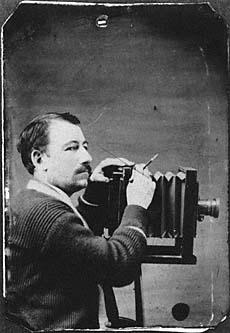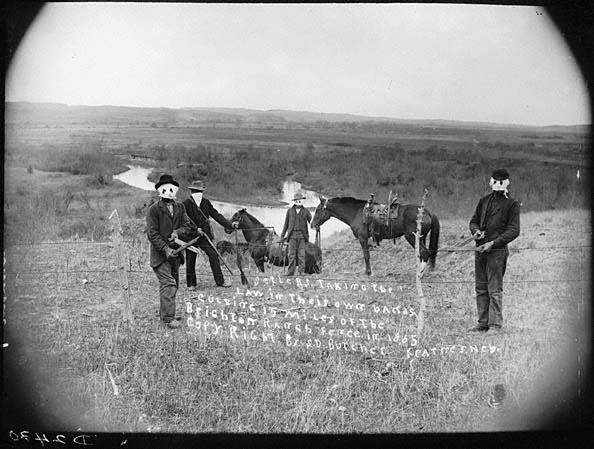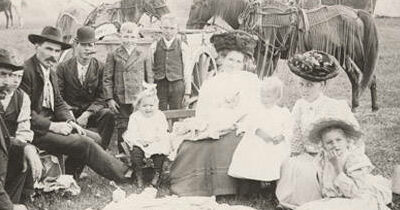
Nebraska photographer Solomon D. Butcher produced, over the course of nearly forty years, a record of the settlement of the Great Plains that is both unique and remarkable. Born in 1856 in what was to become the state of West Virginia after the Civil War, Butcher came with his family to the plains of Nebraska in 1880.
This restless young man soon found that he was not up to the rigors of a homesteader’s life. He had tasted just enough of it, however, to develop a profound admiration for those with the grit to survive and prosper on the Nebraska prairies. In 1886 Butcher was struck with an idea that was inspired. Realizing that the period of settlement would soon be over, he set out to create a photographic history of pioneer life. Between 1886 and 1912 Butcher generated a collection of more than 3,000 photographs.
Though he died in 1927 believing himself a total failure, Solomon D. Butcher’s work has survived to become the most important chronicle of the saga of homesteading in America.
The Solomon D. Butcher Collection comprises 3,300 glass plate negatives crafted between 1886 and 1912. Butcher photographed actively in central Nebraska, including Custer, Buffalo, Dawson, and Cherry counties. His photographs of sod houses have graced textbooks and histories of the American West for more than three-quarters of a century, and are familiar to most Americans.
For nearly forty years the photographs of Solomon D. Butcher (1856-1927) have been used to tell the story of settlement on the Great Plains, including Ken Burns’ and Stephen Ives’ epic television production, “The West.” In 1998 History Nebraska (formerly the Nebraska State Historical Society) received an award from the Library of Congress and Ameritech to digitize the entire glass plate portion of the Butcher collection. This collection is now available online.
Now, these powerful photographs are available to all Nebraskans online. The Library of Congress selected these collections from the holdings of History Nebraska to add to their prestigious American Memory site. As part of the library’s National Digital Library Program, American Memory, which has received substantial funding from the Ameritech Corporation, provides an electronic gateway to the nation’s cultural treasures. American Memory allows the American citizen to directly interact with his or her own past.
A Few of Butcher’s Most Popular Photographs of the Nebraska Homestead Experience
![Sadie Austin [RG2608.PH2436]](https://history.nebraska.gov/wp-content/uploads/2017/09/collections-img_53fs.jpg)
Sadie Austin, the daughter of Cherry County rancher Charles Austin, was a woman of many talents. She was well educated and noted for her refinement, including her accomplishments as a pianist. But, when needed, she was also able to put on a split skirt and help the cowhands. She could sit a horse well and was noted for her shooting ability. She was the best known cowgirl in Cherry County. [RG2608.PH2436]
![Settlers in North Loup River Valley [RG2608.PH2938]](https://history.nebraska.gov/wp-content/uploads/2017/09/collections-img_299fs.jpg)
![Ned Dunlap [RG2608.PH2178a]](https://history.nebraska.gov/wp-content/uploads/2017/09/collections-img_51fs.jpg)
Ned Dunlap, foreman on the Watson Ranch near Kearney, Nebraska. Dunlap had a degree in agriculture from the University of Nebraska and was a man of many talents. In this photograph, he is tricked out to participate in the Old Settler’s Day Parade in Kearney in 1902. For that parade, Dunlap bobbed the tail off his horse and crammed it under his hat. He then affixed a horn to his head, pulled hooves up into his shirt sleeves and marched as Kearney’s only real Cow-Boy! [RG2608.PH2178a]
![Cattle on the Mack Downey ranch [RG2608.PH1756b]](https://history.nebraska.gov/wp-content/uploads/2017/09/collections-img_50fs.jpg)
Cattle on the Mack Downey ranch near Georgetown, Custer County, Nebraska, 1903. The Downey ranch, which stretches to the horizon, was typical of cattle operations in the state. The grass-rich prairie produced superb beef, making Nebraska one of the most important beef producing regions in the world. [RG2608.PH1756b]
![John Bridges at Devil's Gap [RG2608.PH2956]](https://history.nebraska.gov/wp-content/uploads/2017/09/collections-img_49fs.jpg)
John Bridges at Devil’s Gap, site where the notorious Olive Gang hanged homesteaders Mitchell and Ketchum. When the bodies were discovered, they had also been burned. For more information about this amazing story, read The Ladder of Rivers by Harry Chrisman, published in 1962, or The Olive Trial by Carl E. Smith, published in 1973 by the Custer County Historical Society. [RG2608.PH2956]
![The Chrisman sister, 1886 [RG2608.PH1053]](https://history.nebraska.gov/wp-content/uploads/2017/09/collections-img_40fs.jpg)
One of the more famous Butcher photographs: The Chrisman sisters, 1886. Lizzie Chrisman filed the first of the sisters’ homestead claims in 1887. Lutie Chrisman filed the following year. The other two sisters, Jennie Ruth and Hattie, had to wait until they came of age to file. They both filed in 1892. [RG2608.PH1053]
![Lookout Point, Cherry County, Nebraska [RG2608.PH755]](https://history.nebraska.gov/wp-content/uploads/2017/09/collections-img_38fs.jpg)
Lookout Point, Cherry County, Nebraska, near the Snake River. This promontory in the near-mountainous sand hills of Cherry County used to be covered with cedar trees, and was allegedly a spot favored by horse thieves who could hide their booty in the blowout at the top and shinny up a tree to keep a lookout for the law. By the time photographer Solomon Butcher got around to photographing this site, the hill had been scalped bare by timber-hungry settlers. Thus the historic site was ruined. Not to be cheated from his story, Butcher repaired the damage by simply drawing the trees on the negative. [RG2608.PH755]
![The David Hilton family [RG2608.PH3535]](https://history.nebraska.gov/wp-content/uploads/2017/09/collections-img_47fs.jpg)
The David Hilton family near Sargent, Nebraska. Mrs. Hilton and her eldest daughter were adamant that they not be photographed in front of their sod house, because they wished to send copies of the picture to friends and relatives elsewhere and thought it embarrassing to be seen living in a house of dirt. But they did want to be seen with their new pump organ, so they made Mr. Hilton and the photographer drag the organ out of the house for the photographs, then drag it back in again. [RG2608.PH3535]
![James Pierce home on Sand Creek [RG2608.PH2670]](https://history.nebraska.gov/wp-content/uploads/2017/09/collections-img_48fs.jpg)
James Pierce home on Sand Creek, Custer County, Nebraska. Pierce had, as a youth, run away to sea. For twelve years he cruised the Pacific in pursuit of sperm whales. He abandoned his life on the high seas to take a Minnesota homestead, which failed. In 1880 he moved to Nebraska and established the Sommerford post office, named in honor of his English wife’s hometown. The mast-cum-flagpole speaks both to his pride in his new life and as an obvious metaphor for his previous life now transplanted to a sea of grass. [RG2608.PH2670]

“Settlers Taking the Law in Their Own Hands.” This well-known photograph was staged by photographer Solomon D. Butcher to illustrate the tensions between farmers and ranchers created by the appearance of homesteads on the range. It is unlikely, however, that these pantomime desperadoes were likely to do much damage with their wooden wire cutters, a detail lost on many historians over the years who published this photograph as the real McCoy. [RG2608.PH2430]
![The John Curry house, near West Union, Custer County, Nebraska, 1886 [RG2608.PH1048]](https://history.nebraska.gov/wp-content/uploads/2017/09/collections-img_173fs.jpg)
The John Curry house, near West Union, Custer County, Nebraska, 1886. This photograph is often called “Nebraska Gothic.” [RG2608.PH-1048]
![The Shores family, near Westerville, Custer County, Nebraska, 1887 [RG2608.PH1231]](https://history.nebraska.gov/wp-content/uploads/2017/09/collections-img_176fs.jpg)
The Shores family, near Westerville, Custer County, Nebraska, 1887. Jerry Shores was one of a number of former slaves to settle in Custer County. He took a claim adjacent to that of his brothers, Moses Speese and Henry Webb (each had taken the name of his former owner). [RG2608.PH1231]



